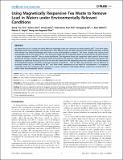Using Magnetically Responsive Tea Waste to Remove Lead in Waters under Environmentally Relevant Conditions
Author(s)
Yeo, Siang Yee; Sow-Peh, Yoke Keow; Qi, Genggeng; Hatton, T. Alan; Doyle, Patrick S.; Thio, Beng Joo Reginald; Choi, Si Won; Dien, Vivian L.; ... Show more Show less
DownloadYeo-2013-Using Magnetically R.pdf (3.807Mb)
PUBLISHER_CC
Publisher with Creative Commons License
Creative Commons Attribution
Terms of use
Metadata
Show full item recordAbstract
We report the use of a simple yet highly effective magnetite-waste tea composite to remove lead(II) (Pb[superscript 2+]) ions from water. Magnetite-waste tea composites were dispersed in four different types of water–deionized (DI), artificial rainwater, artificial groundwater and artificial freshwater–that mimic actual environmental conditions. The water samples had varying initial concentrations (0.16–5.55 ppm) of Pb[superscript 2+] ions and were mixed with the magnetite-waste tea composite for at least 24 hours to allow adsorption of the Pb[superscript 2+] ions to reach equilibrium. The magnetite-waste tea composites were stable in all the water samples for at least 3 months and could be easily removed from the aqueous media via the use of permanent magnets. We detected no significant leaching of iron (Fe) ions into the water from the magnetite-waste tea composites. The percentage of Pb adsorbed onto the magnetite-waste tea composite ranged from ~70% to 100%; the composites were as effective as activated carbon (AC) in removing the Pb[superscript 2+] ions from water, depending on the initial Pb concentration. Our prepared magnetite-waste tea composites show promise as a green, inexpensive and highly effective sorbent for removal of Pb in water under environmentally realistic conditions.
Date issued
2013-06Department
Massachusetts Institute of Technology. Department of Chemical Engineering; Massachusetts Institute of Technology. Department of Materials Science and EngineeringJournal
PLoS ONE
Publisher
Public Library of Science
Citation
Yeo, Siang Yee, Siwon Choi, Vivian Dien, Yoke Keow Sow-Peh, Genggeng Qi, T. Alan Hatton, Patrick S. Doyle, and Beng Joo Reginald Thio. “Using Magnetically Responsive Tea Waste to Remove Lead in Waters under Environmentally Relevant Conditions.” Edited by Zhi Zhou. PLoS ONE 8, no. 6 (June 20, 2013): e66648.
Version: Final published version
ISSN
1932-6203